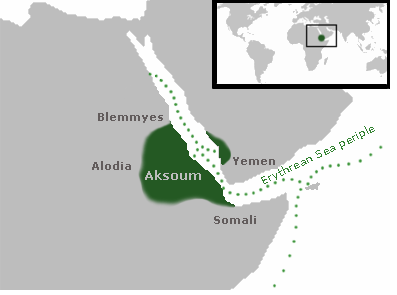 The Aksum Empire (alternately spelled Axum) was a civilization that existed in in northeastern Africa in what is now Ehtiopia and Eritera. Though its existence spans from approximately 100-940 CE, this blog will focus on its first 300 years of history. Below is a basic outline of the civilization's highlights.
The Aksum Empire (alternately spelled Axum) was a civilization that existed in in northeastern Africa in what is now Ehtiopia and Eritera. Though its existence spans from approximately 100-940 CE, this blog will focus on its first 300 years of history. Below is a basic outline of the civilization's highlights.The Aksum Empire was located in northeastern Africa in what is present-day Ethiopia and Eritrea in a plateau area. The Red Sea to the north and the Blue Nile and Lake Tana are nearby water sources. This allowed the civilization to participate in commerce via the Indian Ocean. The land was also much more fertile then than it is now, which allowed wheat and barley to be among their principle crops.
The government was in the form of monarchy, and at its height extended across most of present-day Eritrea, Ethiopia, Western Yemen, southern Saudi Arabia and Sudan. Aksum was a hierarchical society with the king at the top, then nobles, and the general population at the bottom.
The empire originally practiced a polytheistic religion which Attar (or Astar) was the primary god worshiped. Through its trade connections to the Roman world, Christianity found its way to the empire and monarch King Ezana adopted it as the religion of Aksum. This change is also evident in their coinage, in which they replaced the former design of a disc and crescent with the cross.
The capital city of Axum was the center of royal patronage to the arts. In this city were 100-foot tall stone obelisks which most likely marked royal graves. These structures were at the time the tallest structures in the world made from a single piece of rock.
Aksum's location made it an economically important location during its time. It linked trade between India and the Mediterranean, exporting ivory, tortoise shell, gold and emeralds, and importing silk and spices.
Among one of the Aksum's developments included a system of coinage, the first native currency issued in Africa without direct control by an outside culture such as the Romans.This was significant because it proclaimed that the empire considered itself equal to its neighbors. Gold, silver and bronze coins were minted. Another development was their written alphabet galled Geez. With its origins from a script derived from South Arabia, it was eventually modified to include vowels.
SOURCES:
Strayer textbook, pg. 286-288http://www.newworldencyclopedia.org/entry/Axum
http://www.britishmuseum.org/pdf/KingdomOfAksum_TeachersNotes.pdf
Did you find any interesting pictures or links in your reasearch?
ReplyDeleteI think the overview was a great summary but maybe a little more detail? I would love to know more about the demography?? What was the population like, what affected it? I liked the visual!
ReplyDeleteWhat kind of technology did the Askum people use to create the stone obelisks?
ReplyDeleteDid they use their exports(ivory, tortoise shell, gold, emeralds, etc...) to create any forms of art, like jewelry or sculptures?
ReplyDeleteYou stated that, "The capital city of Axum was the center of royal patronage to the arts." I would have like it if you went into more detail about this because it must have been very important seeing that it was in the capital city.
ReplyDeleteWhat kind of commerce did they take part in?
ReplyDeleteWas this monarchy ruled by a single royal family? If not, how were monarchs chosen to rule?
ReplyDeleteThis is yet another vibrant empire that I've never seen or heard of before! Could you tell us how the Aksum interacted with the nearby Egyptians, Nubians, or Meroë civilizations?
ReplyDelete